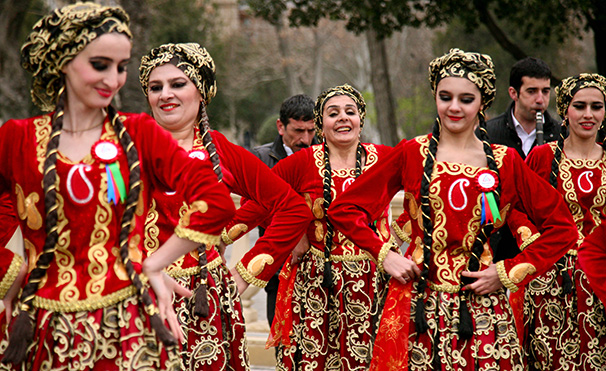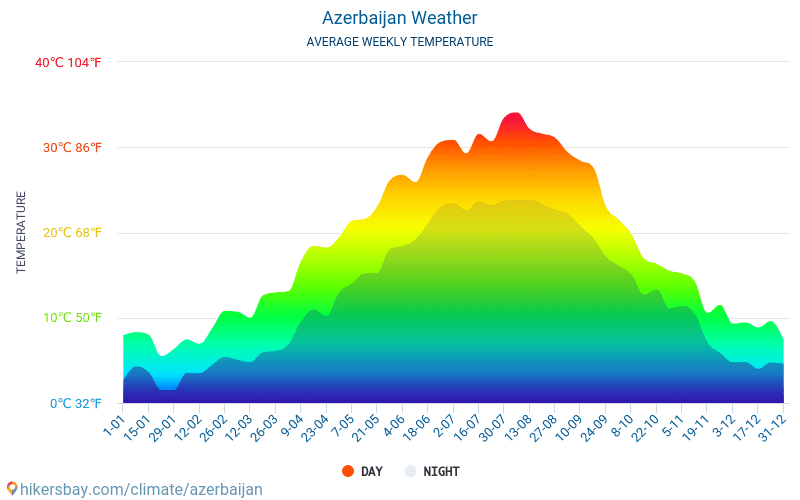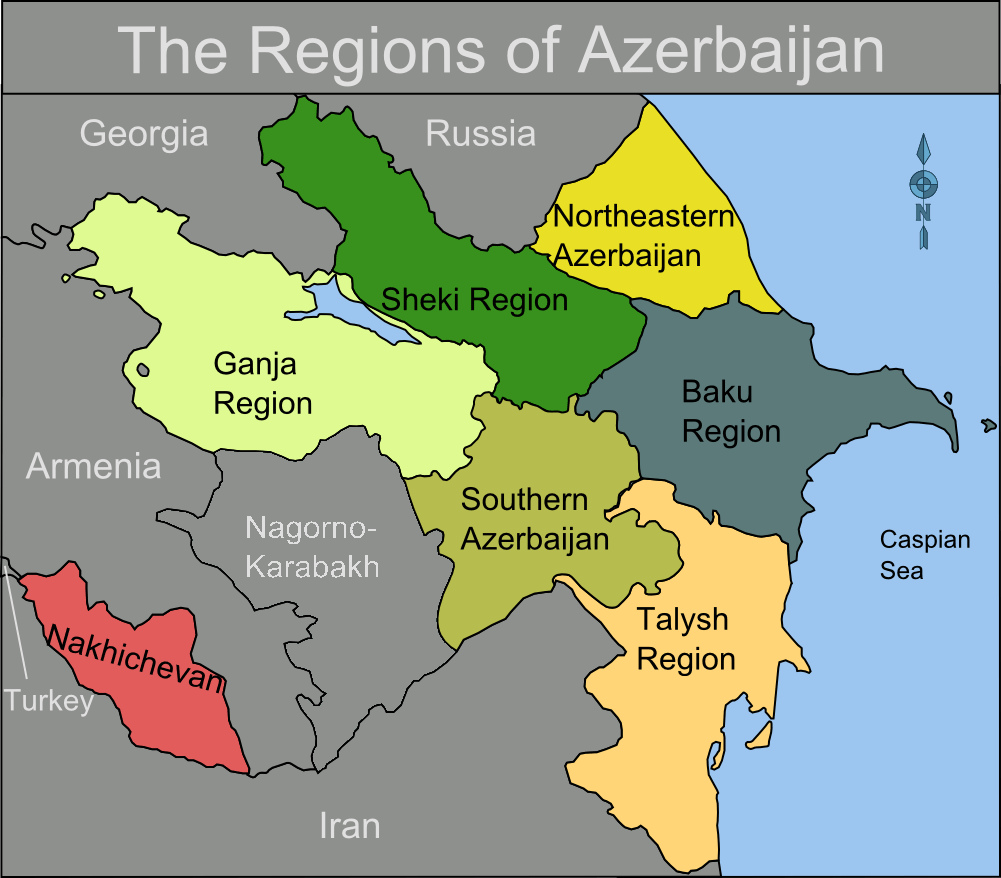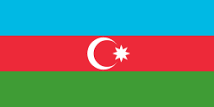Area: 86 600 km²
The Azerbaijan Democratic Republic proclaimed its independence in 1918 and became the first democratic state in the Muslim-oriented world. The country was incorporated into the Soviet Union in 1920 as the Azerbaijan Soviet Socialist Republic. The modern Republic of Azerbaijan proclaimed its independence on 30 August 1991, prior to the official dissolution of the USSR in December 1991. In September 1991, the Armenian majority of the disputed Nagorno-Karabakh region seceded to form the Republic of Artsakh.[11] The region and seven adjacent districts outside it became de facto independent with the end of the Nagorno-Karabakh War in 1994. These regions are internationally recognized as part of Azerbaijan pending a solution to the status of the Nagorno-Karabakh, found through negotiations facilitated by the OSCE. The sovereign state of Azerbaijan is a unitary semi-presidential republic. It's a member state of the Council of Europe, the OSCE, and the NATO Partnership for Peace (PfP) program. It is one of six independent Turkic states and an active member of the Turkic Council and the TÜRKSOY community. Azerbaijan has diplomatic relations with 158 countries and holds membership in 38 international organizations. It is one of the founding members of GUAM, the Commonwealth of Independent States (CIS) and the Organization for the Prohibition of Chemical Weapons. A member of the United Nations since 1992 after its independence, Azerbaijan was elected to membership in the newly established Human Rights Council by the United Nations General Assemblyon 9 May 2006. Its term of office began on 19 June 2006. Azerbaijan is also a member state of the Non-Aligned Movement, holds observer status in World Trade Organization, and is a correspondent at the International Telecommunication Union. The Constitution of Azerbaijan does not declare an official religion and all major political forces in the country are secularist. However, the majority of the population are of Muslim background. More than 89% of the population is Shia. Most Azerbaijanis, however, do not actively practice any religion, with 53% stating religion has little to no importance in their lives, according to Pew Research Center and Gallup polls. Alcohol and non-Islamic places are also permitted. Azerbaijan has a high level of human development which ranks on par with most Eastern European countries. It has a high rate of economic development and literacy, as well as a low rate of unemployment. However, the ruling party, the New Azerbaijan Party, has been accused of authoritarianism and human rights abuses.
Biodiversity
The first reports on the richness and diversity of animal life in Azerbaijan can be found in travel notes of Eastern travelers. Animal carvings on architectural monuments, ancient rocks and stones survived up to the present times. The first information on the flora and fauna of Azerbaijan was collected during the visits of naturalists to Azerbaijan in the 17th century. There are 106 species of mammals, 97 species of fish, 363 species of birds, 10 species of amphibians and 52 species of reptiles which have been recorded and classified in Azerbaijan. The national animal of Azerbaijan is the Karabakh horse, a mountain-steppe racing and riding horse endemic to Azerbaijan. The Karabakh horse has a reputation for its good temper, speed, elegance and intelligence. It is one of the oldest breeds, with ancestry dating to the ancient world. However, today the horse is an endangered species.
Cuisine

The traditional cuisine is famous for an abundance of vegetables and greens used seasonally in the dishes. Fresh herbs, including mint, cilantro (coriander), dill, basil, parsley, tarragon, leeks, chives, thyme, marjoram, green onion, and watercress, are very popular and often accompany main dishes on the table. Climatic diversity and fertility of the land are reflected in the national dishes, which are based on fish from the Caspian Sea, local meat (mainly mutton and beef), and an abundance of seasonal vegetables and greens. Saffron-rice plov is the flagship food in Azerbaijan and black tea is the national beverage. Azerbaijanis often use traditional armudu (pear-shaped) glass as they have very strong tea culture. Popular traditional dishes include bozbash (lamb soup that exists in several regional varieties with the addition of different vegetables), qutab (fried turnover with a filling of greens or minced meat) and dushbara (sort of dumplings of dough filled with ground meat and flavor).
Culture

The culture of Azerbaijan has developed as a result of many influences. Today, national traditions are well preserved in the country despite Western influences, including globalized consumer culture. Some of the main elements of the Azerbaijani culture are: music, literature, folk dances and art, cuisine, architecture, cinematography and Novruz Bayram. The latter is derived from the traditional celebration of the New Year in the ancient Iranian religion of Zoroastrianism. Novruz is a family holiday.
Economy
After gaining independence in 1991, Azerbaijan became a member of the International Monetary Fund, the World Bank, the European Bank for Reconstruction and Development, the Islamic Development Bank and the Asian Development Bank. The banking system of Azerbaijan consists of the Central Bank of Azerbaijan, commercial banks and non-banking credit organizations. The National (now Central) Bank was created in 1992 based on the Azerbaijan State Savings Bank, an affiliate of the former State Savings Bank of the USSR. The Central Bank serves as Azerbaijan's central bank, empowered to issue the national currency, the Azerbaijani manat, and to supervise all commercial banks. Two major commercial banks are UniBank and the state-owned International Bank of Azerbaijan, run by Dr. Jahangir Hajiyev.
Energy
Two-thirds of Azerbaijan is rich in oil and natural gas. The history of the oil industry of Azerbaijan dates back to the ancient period. Arabian historian and traveler Ahmed Al-Belaruri discussed the economy of the Absheron peninsula in anntiquity, mentioning its oil in particular. The region of the Lesser Caucasus accounts for most of the country's gold, silver, iron, copper, titanium, chromium, manganese, cobalt, molybdenum, complex ore and antimony. In September 1994, a 30-year contract was signed between the State Oil Company of Azerbaijan Republic (SOCAR) and 13 oil companies, among them Amoco, BP, ExxonMobil, Lukoil and Equinor. As Western oil companies are able to tap deepwater oilfields untouched by the Soviet exploitation, Azerbaijan is considered one of the most important spots in the world for oil exploration and development. Meanwhile, the State Oil Fund of Azerbaijan was established as an extra-budgetary fund to ensure macroeconomic stability, transparency in the management of oil revenue, and safeguarding of resources for future generations.
Ethnic groups
The ethnic composition of the population according to the 2009 population census: 91.60% Azerbaijanis, 2.02% Lezgians, 1.35% Armenians (almost all Armenians live in the break-away region of Nagorno-Karabakh), 1.34% Russians, 1.26% Talysh, 0.56% Avars, 0.43% Turks, 0.29% Tatars, 0.28% Tats, 0.24% Ukrainians, 0.14% Tsakhurs, 0.11% Georgians, 0.10% Jews, 0.07% Kurds, other 0.21%. Iranian Azerbaijanis are by far the largest minority in Iran. The number of ethnic Azerbaijanis in Iran furthermore far outnumber those in neighboring Azerbaijan. The CIA World Factbook estimates Iranian Azerbaijanis as constituting at least 16% of Iran's population.
Foreign relations
The short-lived Azerbaijan Democratic Republic succeeded in establishing diplomatic relations with six countries, sending diplomatic representatives to Germany and Finland. The process of international recognition of Azerbaijan's independence from the collapsing Soviet Union lasted roughly one year. The most recent country to recognize Azerbaijan was Bahrain, on 6 November 1996. Full diplomatic relations, including mutual exchanges of missions, were first established with Turkey, Pakistan, the United States, Iran and Israel. Azerbaijan has placed a particular emphasis on its "special relationship" with Turkey. Azerbaijan has diplomatic relations with 158 countries so far and holds membership in 38 international organizations. It holds observer status in the Non-Aligned Movement and World Trade Organization and is a correspondent at the International Telecommunication Union. On 9 May 2006 Azerbaijan was elected to membership in the newly established Human Rights Council by the United Nations General Assembly. The term of office began on 19 June 2006. Azerbaijan for the first time elected as a non-permanent member of the UN Security Council in 2011 with the support of 155 countries.
Landscape
Azerbaijan is home to a vast variety of landscapes. Over half of Azerbaijan's land mass consists of mountain ridges, crests, yailas, and plateaus which rise up to hypsometric levels of 400–1000 meters (including the Middle and Lower lowlands), in some places (Talis, Jeyranchol-Ajinohur and Langabiz-Alat foreranges) up to 100–120 meters, and others from 0–50 meters and up (Qobustan, Absheron). The rest of Azerbaijan's terrain consist of plains and lowlands. Hypsometric marks within the Caucasus region vary from about −28 meters at the Caspian Sea shoreline up to 4,466 meters (Bazardüzü peak). The formation of climate in Azerbaijan is influenced particularly by cold arctic air masses of Scandinavian anticyclone, temperate of Siberian anticyclone, and Central Asian anticyclone. Azerbaijan's diverse landscape affects the ways air masses enter the country. The Greater Caucasus protects the country from direct influences of cold air masses coming from the north. That leads to the formation of subtropical climate on most foothills and plains of the country. Meanwhile, plains and foothills are characterized by high solar radiation rates.
Languages
The official language is Azerbaijani (Turkic language), which is spoken by approximately 92% of the population as a mother tongue. It belongs to the Turkic language family. Russian and Armenian (only in Nagorno-Karabakh) are also spoken, and each are the mother tongue of around 1.5% of the population respectively. Russian and English play significant roles as second or third languages of education and communication.There are a dozen other minority languages spoken natively in the country. Avar, Budukh, Georgian, Juhuri, Khinalug, Kryts, Lezgian, Rutul, Talysh, Tat, Tsakhur, and Udi are all spoken by small minorities. Some of these language communities are very small and their numbers are decreasing. Armenian is almost exclusively spoken in the break-away Nagorno-Karabakh region.
Name
According to a modern etymology, the term Azerbaijan derives from that of Atropates, a Persian satrap under the Achaemenid Empire, who was later reinstated as the satrap of Media under Alexander the Great. The original etymology of this name is thought to have its roots in the once-dominant Zoroastrianism. In the Avesta's Frawardin Yasht ("Hymn to the Guardian Angels"), there is a mention of âterepâtahe ashaonô fravashîm ýazamaide, which literally translates from Avestan as "we worship the fravashi of the holy Atropatene." The name "Atropates" itself is the Greek transliteration of an Old Iranian, probably Median, compounded name with the meaning "Protected by the (Holy) Fire" or "The Land of the (Holy) Fire". The Greek name was mentioned by Diodorus Siculus and Strabo. Over the span of millennia, the name evolved to Āturpātākān (Middle Persian), then to Ādharbādhagān, Ādharbāyagān, Āzarbāydjān (New Persian) and present-day Azerbaijan.
Religion
Around 97% of the population are Muslims. 65-75% of the Muslims are Shia Muslims (the rest being Sunni Muslims,) and the Republic of Azerbaijan has the second highest Shia population percentage in the world. Other faiths are practised by the country's various ethnic groups. Under article 48 of its Constitution, Azerbaijan is a secular state and ensures religious freedom. In a 2006–2008 Gallup poll, only 21% of respondents from Azerbaijan stated that religion is an important part of their daily lives. This makes Azerbaijan the least religious Muslim-majority country in the world.
Transportation
The convenient location of Azerbaijan on the crossroad of major international traffic arteries, such as the Silk Road and the south–north corridor, highlights the strategic importance of transportation sector for the country's economy. The transport sector in the country includes roads, railways, aviation, and maritime transport. Azerbaijan is also an important economic hub in the transportation of raw materials. The Baku–Tbilisi–Ceyhan pipeline (BTC) became operational in May 2006 and extends more than 1,774 kilometers through the territories of Azerbaijan, Georgia and Turkey. The BTC is designed to transport up to 50 million tons of crude oil annually and carries oil from the Caspian Sea oilfields to global markets. The South Caucasus Pipeline, also stretching through the territory of Azerbaijan, Georgia and Turkey, became operational at the end of 2006 and offers additional gas supplies to the European market from the Shah Deniz gas field. Shah Deniz is expected to produce up to 296 billion cubic meters of natural gas per year. Azerbaijan also plays a major role in the EU-sponsored Silk Road Project. In 2002, the Azerbaijani government established the Ministry of Transport with a broad range of policy and regulatory functions. In the same year, the country became a member of the Vienna Convention on Road Traffic. Priorities are upgrading the transport network and improving transportation services in order to better facilitate the development of other sectors of the economy. The construction of Kars–Tbilisi–Baku railway in 2012 is to improve transportation between Asia and Europe by connecting the railways of China and Kazakhstan in the east to the European railway system in the west via Turkey. In 2010 Broad-gauge railways and electrified railways stretched for 2,918 km (1,813 mi) and 1,278 km (794 mi) respectively. By 2010, there were 35 airports and one heliport.
Visual art
A miniature painting of a battle scene on the walls of the Palace of Shaki Khans, 18th century, city of Shaki Azerbaijani art includes one of the oldest art objects in the world, which were discovered as Gamigaya Petroglyphs in the territory of Ordubad Rayon are dated back to the 1st to 4th centuries BC. About 1500 dislodged and carved rock paintings with images of deer, goats, bulls, dogs, snakes, birds, fantastic beings and also people, carriages and various symbols had been found out on basalt rocks. Norwegian ethnographerand adventurer Thor Heyerdahl was convinced that people from the area went to Scandinavia in about 100 AD and took their boat building skills with them, and transmuted them into the Viking boats in Northern Europe.
Climate















